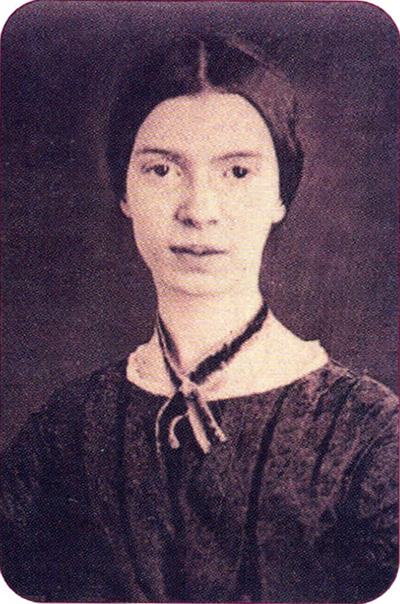One of the best-loved poets, Emily Dickinson, counted her Irish caretakers among her friends.
On May 15, 1886, Emily Dickinson died in her narrow bed in the Dickinson house in Amherst, Massachusetts where she had lived for all but 15 of her 56 years. Her elder bother Austin wrote in his diary: “It was settled before morning broke that Emily would not wake again this side.” She had left behind some of the most extraordinary poems the world would ever read.
Since the publication of the first volume in 1890, Dickinson’s astonishing verse and famously reclusive life have been the focus of a worldwide cult. She has inspired numerous plays, novels, forgeries and countless dissertations, the silliest of these emanating from women’s studies departments where Dickinson is commonly presented either as a victim of patriarchy or as a closet lesbian.
Pilgrims from Japan
This is pilgrimage week for the many loyal if misguided devotees who arrive in Amherst from as far away as Japan to videotape themselves posing beside Dickinson’s grave. I have often noticed them as they try to hide their disappointment. Not only is the gravestone plain and small – bearing the terse inscription “Called Back” – but Amherst has grown up around the modest cemetery and traffic noise makes transcendental thought difficult.
All of this would surely have amused Miss Dickinson. In the second stanza of an early poem she declared: “How dreary / to be / Somebody! How public / like a Frog / To tell your name / the livelong June / To an admiring Bog!” Her funeral, in accordance with her detailed wishes, was her most telling rejection of pomposity. Having expired from Bright’s Disease, or what she termed “Nervous Prostration,” the diminutive Miss Dickinson was wrapped in a white flannel robe made by her sister-in-law. A small bunch of violets was placed by her neck and by her hand two heliotropes which her sister, Lavinia, had picked for Emily “to take to Judge Lord” – of whom more later.
A wreath of violets decorated the plain white coffin as it lay in the hallway. Bees buzzed in through the open front door. After a Scripture reading, a prayer, and a reading of Emily Brontë’s poem “Last Lines,” six men lifted the coffin. As Dickinson had instructed, she was carried out the back door, around the garden, through the open barn from front to back and through three fields, filled with buttercups and daisies, to the Dickinson plot in West Cemetery.
Emily Dickinson’s six chosen pallbearers were Irishmen: Thomas Kelley, Dennis Scannell, Stephen Sullivan, Patrick Ward, Daniel Moynihan, and Dennis Cashman. All worked on the Dickinsons’ land. But the relationship between the poet and her servants is not as tidy as scholars of oppression might wish. One incident in particular reveals its affectionate, even protective nature.
Letters to Judge
In 1882, Emily Dickinson learned that Otis Phillips Lord was gravely ill. She and the eminent Massachusetts jurist had corresponded for years and the surviving letters – censored by Austin – testify to Emily’s passionate devotion. In one of those letters, Dickinson describes hearing of Lord’s illness:
“Vinnie came in from a word with Austin, passing to the Train.”
“‘Emily, did you see anything in the Paper that concerned us?’ ‘Why no, Vinnie, what?’ ‘Mr. Lord is very sick.’ I grasped at a passing Chair. My sight slipped and I thought I was freezing. . .Meanwhile, Tom had come, and I ran to his Blue Jacket and let my Heart break there – that was the warmest place. ‘He will not be better. Don’t cry Miss Emily. I could not see you cry.'”
Fifty-two-year-old Emily Dickinson crying on the chest of a handyman who, distraught at her anguish, pleads, “I could not see you cry.” So much for the stereotype of cold Yankees and brutalized helpers. Tom Kelley had emigrated from Co. Tipperary in 1854. In 1868 he fell while working as a hod carrier on an Amherst factory building and lost his left arm. He was nursed for three months by his wife, Mary Maher, and her sister Margaret who was the Dickinsons’ maid for 15 years and who played an even more intimate role in her mistress’ life.
Once described by Emily as “warm and wild and mighty,” Maher had left Tipperary in the 1850s. She never married and remained in the Dickinson house until Lavinia’s death in 1899. A dedicated nurse, she contracted typhoid in 1882 and received a playful letter from Emily.
“The missing Maggie is much mourned, and I am going out for ‘black’ to the nearest store. All are very naughty, and I am the naughtiest of all.
“The pussies dine on sherry now, and humming-bird cutlets. . .What shall I send my weary Maggie? Pillows or fresh brooks? Her grieved Mistress.”
To which Maher replied: “Send me something drawen on paper.”
Bundles of Poetry
In her deposition at the 1897 courtroom wrangle over Austin Dickinson’s estate, Maher revealed in passing that Emily had kept her bundles of poetry in the maid’s trunk, and historians speculate that the poet may have asked Maher to burn them on her death. It seems certain that the only known image of Emily – the famous daguerreotype taken at Mount Holyoke College and discarded by the family – was saved by Maher, who offered it for inclusion in the first volume of Dickinson’s poetry.
Margaret Maher was buried in 1924 in a large cemetery in neighboring Northampton, with far greater pomp than her mistress. Her occupation – nurse, domestic servant – could not be plainer than Emily Dickinson’s description of herself. In Dickinson’s death certificate, the occupation of the woman who never called herself a poet is given simply as “At Home”.
_______________
Reprinted with the permission of The Irish Times (www.ireland.com).


Leave a Reply